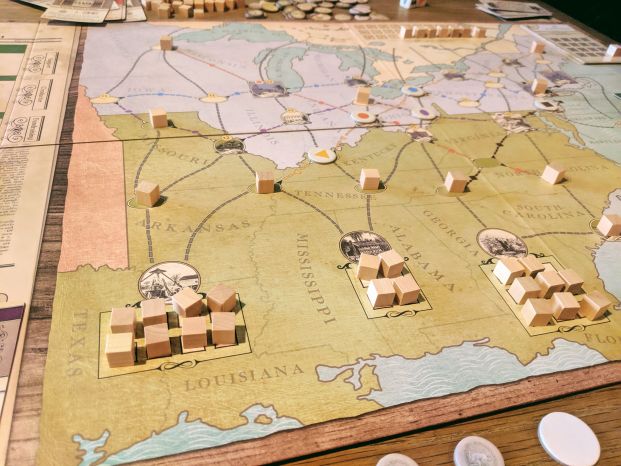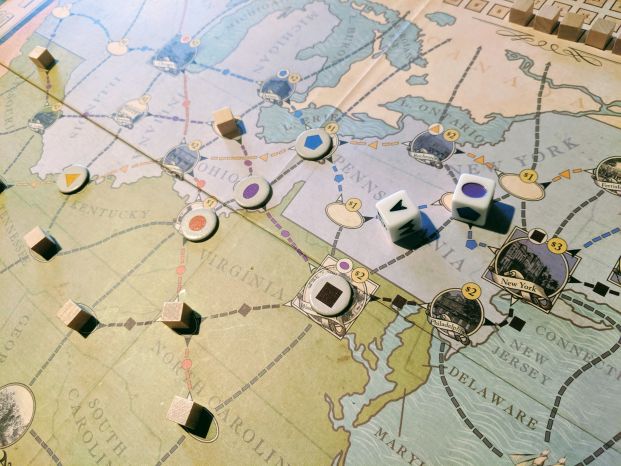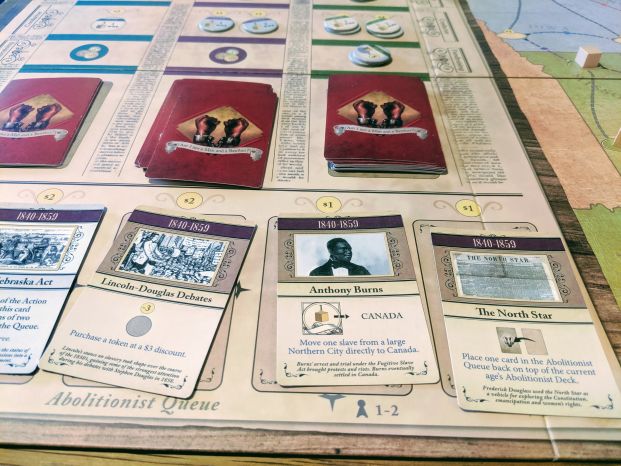“I am going to move these guys out of Louisiana so you will have some space in the plantations.”
“Hmm, strictly speaking, if we let this shipment get… “lost” we could win in 2 rounds.”
“I know but I am also really not comfortable with letting a whole shipment of slaves getting “lost”, even if we would still be within the win conditions.”
“Okay, okay, I’ll take care of the plantations.”
Freedom: The Underground Railroad is a co-operative game in which players fight slavery and work tirelessly to help slaves escape from the Deep South to Canada, the promised land.
The game takes place during the 19th century in North America, and guides you through the struggle to abolish slavery. You will have to fight for the general support of the population in order to make permanent changes, evade slave catchers, and help slaves move through land and sea. The theme oozes through every move you have to make, every choice, every sacrifice. Sometimes the way forward will be clear and easy to see, sometimes you options will be murky and morally questionable. Is it even possible to stay true to one’s principles and morals in Freedom: The Underground Railroad‘s harsh world? Or more accurately, in our world? Let’s find out.
Mechanically the game is very simple: you need to move the light brown cubes, aka slaves, through the map. The victory condition is to get a certain number of slaves to Canada, so that they become free men while making sure that the number of “lost” slaves does not exceed a certain number.

The game consists of eight rounds, each of which has five phases. The first one is the slave-catcher phase. There are several slave-catcher tokens on the North side of the US who move randomly based on dice rolls. Following that comes the planning phase. Players can buy different kinds of tokens that can be used to gain support, to raise funds, or to move slaves (called conductor tokens). Once all the players are happy with their choices (considering the circumstances), they can do their actions. That means players can use up to two of their tokens, do their role’s special action, and/or buy and resolve an abolitionist card, which we will circle back to later. After the action phase comes the slave market, and a new shipment of slaves is sold to the plantations. If there is no more room at the plantations in the South the excess slaves get “lost”. The final phase is a bit of a clean-up, abolitionist cards get shifted, first player token gets passed, players check for victory. And this is basically the game, it is pretty simple and neat.
There is of course more nuance to it. Slave-catchers have their own colored routes, and if a slave moves to a city on their route the corresponding catcher will advance one space towards that slave, like an evil bloodhound. I know how weird this sounds but this mechanism makes moving slaves an intriguing puzzle, where you don’t just move cubes towards North in a straight line, but you push them strategically to trigger slave-catcher movements to clear the way for other cubes.
You also have several ways of getting money in the game. Most straightforward one is through fundraising tokens, but there is only a limited amount of those available, and keeping up the underground railroad is expensive. What can you do? Some roles have a steady income, albeit not much, and on top of that if a slave enters a Northern city, you get money, representing the support of the locals. This leads to interesting situations where you have a cube close to Canada, and you could just move them into safety, freedom and liberty… or you could waltz them around the border cities to gather some money and risk slave-catchers, well, catching up. If you risk another move to that city near lake Ontario you could get $2 and then the next round use that money to buy a conductor token so you can move 4 slaves, but that yellow slave-catcher is getting really close and you could just save this particular cube, but then what do you do next round without money… It is a tough decision.
The abolitionist cards are also a nice touch. They depict historical figures and events and they give bonuses like moving slaves without slave-catchers reacting or raising money. However, for each game you need to add opposition cards to the deck that try to thwart your efforts by limiting tokens available or funds or anything else that might make your life miserable. These represent the opposition, people who were not against the idea of slavery.
The game also features different role cards that have special abilities. Some roles make it possible to move slaves more easily, some buy abolitionist cards at a discount, and some are better at avoiding slave-catchers.
The Good
The rules are pretty simple, I think I have summarized basically all of them above. Every turn you take two tokens, get some gold, buy and resolve cards, move cubes, check for victory.
The slave-catcher mechanism is great. I mean, slave-catchers in general are bad, but the puzzle they represent in the game is intriguing and they really make it feel like slaves just barely slip through to Canada. It is also possible to get stuck for some slaves, all routes being blocked, and then you have solve the conundrum by cleverly getting the catchers attention by other runaway slaves so the original ones can quickly run for Canada.

Even though the gameplay is simple and straightforward, the struggle feels difficult and desperate. Shipments keep coming, but you usually can’t move that many slaves each round, especially with the slave-catchers patrolling, so you end up making difficult choices, and occasionally sacrificing “cubes” for the greater good. The game is very thematic, maybe even too much as it will make some people uncomfortable. I am putting this down as a good things because such a strong sense of theme is rare in a board game.
Probably this is the reason why the game is so engaging, we won our first game and just kept going because it was interesting and we wanted to see how many more slaves we can save.
The Bad
The art is a bit bland, it looks very educational, which isn’t necessarily a bad thing, but as reviewers we are not school kids, so we would have appreciated something nicer.
Some game mechanisms are a bit weird when you think about them. The slave catchers are only up north, so you end up in a weird situation where slaves are safe running around down south but are in danger once they get north.
Furthermore there isn’t really any escalation in the game, the players get slightly more powerful thanks to the better tokens and abolitionist cards, but the threat remains the same. There are co-op games that end with a desperate push or a satisfying big win, this one kinda falls between the two. You get the last slave to Canada but you can still see the little brown cubes on the plantations so you know your work isn’t really done but the game ends nonetheless. I know it is difficult to make a satisfying end to a game like this, but the statement is still true.

The Co-Op
The co-op is okay, you will end up brainstorming together, occasionally setting up each other’s rounds, but sometimes your round will just be a game of solitaire. You might also end up having awkward conversations on who is more heartless and pragmatic and who is a real Captain America not leaving anyone behind. The interactions mainly come from the conversation you are going to have at the table, the player abilities don’t really impact others.
The Recommendation
We had a good time playing Freedom: The Underground Railroad, however morbid that sounds, so we do recommend it for advanced gamers, with the caveat that be prepared to feel awkward. Occasionally really awkward. In term of number of players two players felt about right, probably wouldn’t recommend with more.
Freedom: The Underground Railroad is a good, tight game, I don’t think there is much room for expansions, and hopefully there won’t be any sequels.
Info
| Release Year | 2012 |
| Genre | Strategy |
| Difficulty | Medium |
| Number of Players | 1 to 4 |
| Length | 60 - 90 minutes |
Rating
| Overall | Good |
| Story | Great |
| Co-Operation | Mediocre |